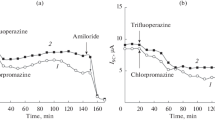Abstract
Intracellular ion concentrations were determined in split skins of Rana pipiens using the technique of electron microprobe analysis. Based on the 1 min Br uptake from the apical bath, two types of mitochondria-rich (MR) cells could be distinguished: active cells which rapidly exchanged their anions with the apical bath and inactive cells which did not. Br uptake and frequency of active MR cells were closely correlated with the skin conductance, g t. Replacing Cl in the apical bath with an impermeant anion significantly lowered g t and the Br uptake and Na concentration of active cells. Even larger reductions were observed after apical amiloride (0.1 mm). The inhibition of the Br uptake was reversible by voltage clamping (100 mV, inside positive). Cl removal and amiloride also led to some shrinkage of active cells. The results suggest that the active cell is responsible for a large part of g t. Inactive MR cells had much lower Br and Na concentrations which were not significantly affected by Cl removal, amiloride, or voltage clamping. Principal cells, which represent the main cell type of the epithelium, showed only a minimal Br uptake from the apical side which was not correlated with g t. Moreover, Cl removal had no effect on the Na, Br, and Cl concentrations of principal cells.
Similar content being viewed by others
References
Bauer, R., Rick, R. 1978. Computer analysis of x-ray spectra (EDS) from thin biological specimens. X-Ray Spectrom. 7:63–69
Biber, T.U.L., Drewnowska, K., Baumgarten, C.M., Fisher, R.S. 1985. Intracellular Cl activity changes of frog skin. Am. J. Physiol. 249:F432–438
Blatter, L.A. 1991. Estimation of intracellular free magnesium using ion-selective microelectrodes: Evidence for an Na/Mg exchange mechanism in skeletal muscle. Magnes. Trace Elem. 10:67–69
Dörge, A., Rick, R., Beck, F.X., Nagel, W. 1988. Uptake of Br in mitochondria-rich and principal cells of toad skin epithelium. Pfluegers Arch. 412:305–313
Dörge, A., Rick, R., Beck, F.X., Thurau, K. 1985. Cl transport across the basolateral membrane in frog skin epithelium. Pfluegers Arch. 405:S8-S11
Drewnowska, K., Biber, T.U.L. 1985. Active transport and exchange diffusion of Cl across the isolated skin of Rana pipiens. Am. J. Physiol. 249:F424–431
Ehrenfeld, J., Garcia-Romeu, F. 1977. Active hydrogen excretion and sodium absorption through isolated frog skin. Am. J. Physiol. 233:F46-F54
Foskett, K.J., Ussing, H.H. 1986. Localization of chloride conductance to mitochondria-rich cells in frog skin epithelium. J. Membrane Biol. 91:251–258
Harck, A.F., Larsen, E.H. 1986. Concentration dependence of halide fluxes and selectivity of the anion pathway in toad skin. Acta Physiol. Scand. 128:289–304
Harvey, B.J. 1992. Energization of sodium absorption by the H+-AT-Pase pump in mitochondria-rich cells of frog skin. J. Exp. Biol. 172:289–309
Katz, U., Scheffey, C. 1986. The voltage-dependent chloride conductance of toad skin is localized to mitochondria-rich cells. Biochim. Biophys. Acta 831:480–482
Kristensen, P. 1983. Exchange diffusion, electrodiffusion, and rectification in the chloride transport pathway in frog skin. J. Membrane Biol. 72:141–151
Larsen, E.H. 1991. Chloride transport by high-resistance heterocellular epithelia. Physiol. Rev. 71:235–284
Larsen, E.H., Rasmussen, B.E. 1985. A mathematical model of amphibian skin epithelium with two types of transporting cellular units. Pfluegers Arch. 405:S50–58
Larsen, E.H., Ussing, H.H., Spring, K.R. 1987. Ion transport by mitochondria-rich cells in toad skin. J. Membrane Biol. 99:25–40
Nagel, W. 1989. Chloride conductance of frog skin: localization to the tight junctions? Miner. Electrolyte Metab. 15:163–70
Nagel, W., Dörge, A. 1990. Analysis of anion conductance in frog skin. Pfluegers Arch. 416:53–61
Rick, R. 1992. Intracellular ion concentrations in the isolated frog skin epithelium: Evidence for different types of mitochondria-rich cells. J. Membrane Biol. 127:227–238
Rick, R., Dörge, A., Arnim, E. von, Thurau, K. 1978. Electron microprobe analysis of frog skin epithelium: evidence for a syncytial sodium transport compartment. J. Membrane Biol. 39:313–331
Rick, R., Dörge, A., Beck, F.X., Thurau, K. 1986. Electron probe X-ray microanalysis of transepithelial ion transport. Ann. NY Acad. Sci. 483:245–259
Rick, R., Dörge, A., Sesselmann, E. 1988. Na transport stimulation by novobiocin: transepithelial parameters and evaluation of ENa. Pfluegers Arch. 411:243–251
Rick, R., Dörge, A., Thurau, K. 1982. Quantitative analysis of electrolytes in frozen dried sections. J. Microsc. 125:239–247
Rick, R., Roloff, C., Dörge, A., Beck, F.X., Thurau, K. 1984. Intracellular electrolyte concentrations in the frog skin epithelium: Effect of vasopressin and dependence on the Na concentration in the bathing media. J. Membrane Biol. 78:129–145
Spring, K.R., Ussing, H.H. 1986. The volume of mitochondria-rich cells of frog skin epithelium. J. Membrane Biol. 92:21–26
Steinmetz, P.R. 1986. Cellular organization of urinary acidification. Am. J. Physiol. 251:F173–187
Ussing, H.H., Windhager, E.E. 1964. Nature of shunt path and active sodium transport path through frog skin epithelium. Acta Physiol. Scand. 61:484–504
Voûte, C.L., Meier, W. 1978. The mitochondria-rich cells of frog skin as hormone sensitive “shunt path”. J. Membrane Biol. 40:151–165
Watlington, C.O., Sessee, F., Jr. 1973. Chloride-flux across frog skin of low potential difference. Biochim.Biophys. Acta 330:102–107
Willumsen, N.J., Larsen, E.H. 1985. Passive Cl− currents in toad skin: potential dependence and relation to mitochondria-rich cell density. In: Transport Processes, Inoand Osmoregulation. R. Gilles, M. Gilles-Baillien, editors, pp. 20–30. Springer-Verlag, Berlin
Willumsen, N.J., Larsen, E.H. 1986. Membrane potentials and intracellular Cl− activity of toad skin epithelium in relation to activation and deactivation of the transepithelial Cl− conductance. J. Membrane Biol. 94:173–190
Author information
Authors and Affiliations
Additional information
I wish to thank Cathy Langford for her excellent technical assistance. Financial support was provided by National Institutes of Health grants DK35717 and 1S10-RR0-234501.
Rights and permissions
About this article
Cite this article
Rick, R. Short-term bromide uptake in skins of Rana pipiens . J. Membarin Biol. 138, 171–179 (1994). https://doi.org/10.1007/BF00232645
Received:
Revised:
Issue Date:
DOI: https://doi.org/10.1007/BF00232645




